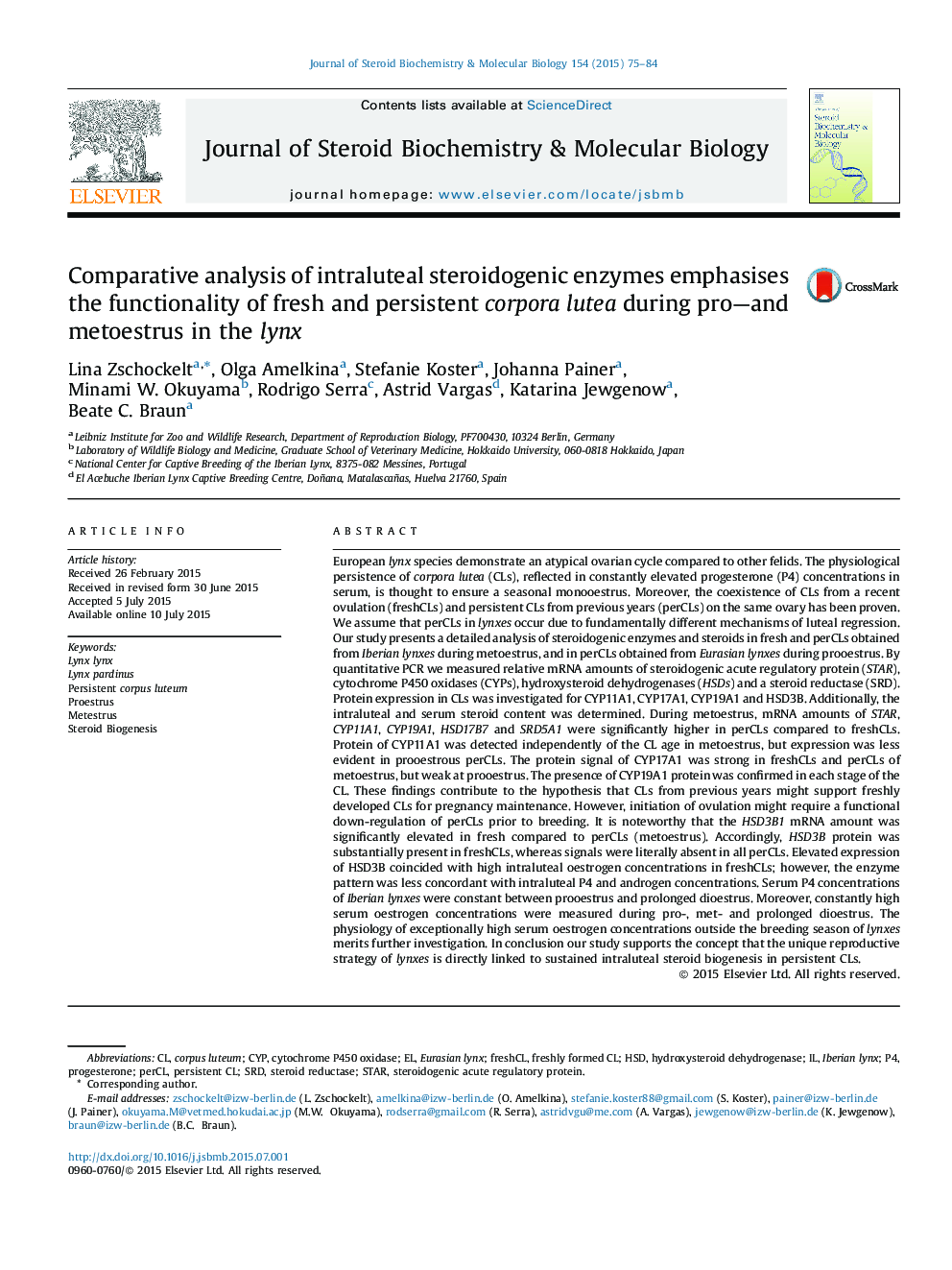| کد مقاله | کد نشریه | سال انتشار | مقاله انگلیسی | نسخه تمام متن |
|---|---|---|---|---|
| 1991302 | 1540995 | 2015 | 10 صفحه PDF | دانلود رایگان |
عنوان انگلیسی مقاله ISI
Comparative analysis of intraluteal steroidogenic enzymes emphasises the functionality of fresh and persistent corpora lutea during pro-and metoestrus in the lynx
ترجمه فارسی عنوان
تجزیه و تحلیل مقایسهای آنزیم های استروئیدوژنیک بین درون سلولی تاکید بر عملکرد فلفل تازه و ماندگار در طول پروتئین و متئوستروس در ماهی قزل آلا
دانلود مقاله + سفارش ترجمه
دانلود مقاله ISI انگلیسی
رایگان برای ایرانیان
کلمات کلیدی
موضوعات مرتبط
علوم زیستی و بیوفناوری
بیوشیمی، ژنتیک و زیست شناسی مولکولی
زیست شیمی
چکیده انگلیسی
European lynx species demonstrate an atypical ovarian cycle compared to other felids. The physiological persistence of corpora lutea (CLs), reflected in constantly elevated progesterone (P4) concentrations in serum, is thought to ensure a seasonal monooestrus. Moreover, the coexistence of CLs from a recent ovulation (freshCLs) and persistent CLs from previous years (perCLs) on the same ovary has been proven. We assume that perCLs in lynxes occur due to fundamentally different mechanisms of luteal regression. Our study presents a detailed analysis of steroidogenic enzymes and steroids in fresh and perCLs obtained from Iberian lynxes during metoestrus, and in perCLs obtained from Eurasian lynxes during prooestrus. By quantitative PCR we measured relative mRNA amounts of steroidogenic acute regulatory protein (STAR), cytochrome P450 oxidases (CYPs), hydroxysteroid dehydrogenases (HSDs) and a steroid reductase (SRD). Protein expression in CLs was investigated for CYP11A1, CYP17A1, CYP19A1 and HSD3B. Additionally, the intraluteal and serum steroid content was determined. During metoestrus, mRNA amounts of STAR, CYP11A1, CYP19A1, HSD17B7 and SRD5A1 were significantly higher in perCLs compared to freshCLs. Protein of CYP11A1 was detected independently of the CL age in metoestrus, but expression was less evident in prooestrous perCLs. The protein signal of CYP17A1 was strong in freshCLs and perCLs of metoestrus, but weak at prooestrus. The presence of CYP19A1 protein was confirmed in each stage of the CL. These findings contribute to the hypothesis that CLs from previous years might support freshly developed CLs for pregnancy maintenance. However, initiation of ovulation might require a functional down-regulation of perCLs prior to breeding. It is noteworthy that the HSD3B1 mRNA amount was significantly elevated in fresh compared to perCLs (metoestrus). Accordingly, HSD3B protein was substantially present in freshCLs, whereas signals were literally absent in all perCLs. Elevated expression of HSD3B coincided with high intraluteal oestrogen concentrations in freshCLs; however, the enzyme pattern was less concordant with intraluteal P4 and androgen concentrations. Serum P4 concentrations of Iberian lynxes were constant between prooestrus and prolonged dioestrus. Moreover, constantly high serum oestrogen concentrations were measured during pro-, met- and prolonged dioestrus. The physiology of exceptionally high serum oestrogen concentrations outside the breeding season of lynxes merits further investigation. In conclusion our study supports the concept that the unique reproductive strategy of lynxes is directly linked to sustained intraluteal steroid biogenesis in persistent CLs.
ناشر
Database: Elsevier - ScienceDirect (ساینس دایرکت)
Journal: The Journal of Steroid Biochemistry and Molecular Biology - Volume 154, November 2015, Pages 75-84
Journal: The Journal of Steroid Biochemistry and Molecular Biology - Volume 154, November 2015, Pages 75-84
نویسندگان
Lina Zschockelt, Olga Amelkina, Stefanie Koster, Johanna Painer, Minami W. Okuyama, Rodrigo Serra, Astrid Vargas, Katarina Jewgenow, Beate C. Braun,
